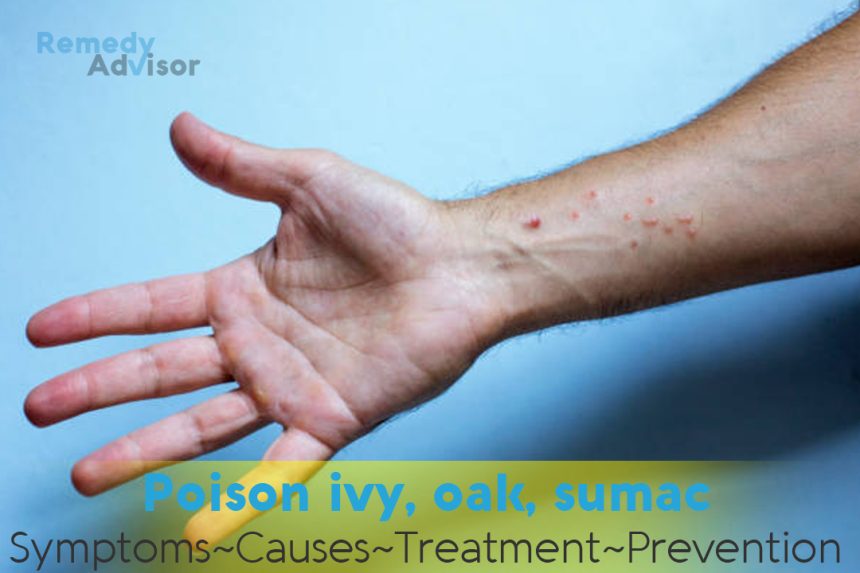What is it
The itching and the rash associated with poison ivy, oak, or sumac are immune-system reactions that result from either touching the plants directly or coming in contact with clothing, garden tools, or pets that have been exposed to the plants. About 85 percent of the population will develop symptoms, which may take one to two weeks to develop on first contact but which can then last for days.
Symptoms
- Red, bumpy, itchy rash at the site of exposure, often followed by small blisters.
- Localized swelling of the skin.
What causes it
The source of the allergic reaction is urushiol (you-ROO-she-all), a colorless or sometimes slightly yellow oil that occurs in the sap of the plant genus Rhus. Poison ivy, oak, and sumac all belong to this genus (cashews and mangos are close relatives). The plants are scattered around most of the United States and Canada.
Just one billionth of a gram of urushiol is enough to make allergic people itch inces sandy. The chemical is also very durable if you don’t wash it off clothing, shoes, or tools, it will still be there many months hence and can cause a reaction.
What if you do nothing
Sensitivity to poison ivy varies from person to person, with individual sensitivity diminishing as one gets older (However at any age the first attack of poison ivy can be rather severe). Once contracted, poison ivy rash, blisters, and itch will normally disappear in 14 to 20 days without any treatment. Still, most people will need relief from the intense itch; some may require prescription medication.
Home remedies
If you think you have come in contact with any of the poison plants, here’s what to do.
Wash your exposed skin immediately
Wash with soap and lots of water within 5 to 10 minutes if possible. The longer you wait, the less effective washing becomes. If you’re out in the woods, use water from a lake or stream, or even beer from a picnic basket if you have any.
Apply rubbing alcohol
This inactivates any remaining urushiol. Don’t use a washcloth; this can spread urushiol. Instead, dab your skin with alcohol-soaked cotton balls.
Clean your clothing and anything else exposed to the plants
Urushiol can spread from clothing to you, so be extremely careful when undressing. Wear rubber gloves while handling clothes and other items, and then discard the gloves. Wash the contaminated clothes (separately from other clothes) in strong detergent.
Shoes, tools, and other items that may have been in contact with urushiol need to be wiped off with alcohol and water. A poison ivy rash that causes mild to moderate itching may take one to two weeks to develop after initial exposure to the oil, and then only two or three days after any subsequent exposure. Here are pointers for taking care of the rash.
Try not to scratch
Scratching can lead to infection. However, contrary to popular myth, scratching the rash (and breaking the blisters) won’t cause the rash to spread, since the water inside the blisters does not contain urushiol. In fact, once the rash appears, the urushiol is gone from that area which is why the rash won’t spread elsewhere on you or from you to someone who might come in contact with it.
Try calamine lotion
For mild cases that afflict small areas, this popular lotion cools the skin and causes the blood vessels to constrict. Lotion leaves a dusty residue that absorbs the oozing and grows a crust that keeps it from sticking to your outfit. Apply it to the scratchy parts every three to four hours. Stop after the oozing stops.
Nonprescription creams can also help
For mild itching, 1 percent cortisone creams twice the strength of the old 0.5 percent formulations can provide relief However, over-the-counter cortisone creams won’t help if you have severe itching.
Have a milk soak
A compress with cold milk helps dry the rash and soothe the itch. Just soak milk in gauze and apply to your skin for 5 to 1 minutes.
Soak in the tub
A tepid tub bath, two to six times daily, with colloidal oatmeal (Aveeno) added, may be soothing. Since the oatmeal makes the tub slick, be sure to have a nonskid bath mat in place.
Rub on baking soda
If your rash is weeping or blistering, make a paste of water and baking soda and apply it to your skin. This helps dry up the oozing blisters.
Ice it
The cheapest remedy for the itch of poi- son ivy is to apply an ice cube to the affected area for about a minute. If you don’t have an ice cube, run cold water over the area.
Prevention
Being able to recognize these poisonous plants is the key to avoiding them and the rash that they trigger. The old adage “Leaflets three, let it be” is accurate. But the poisonous plants vary tremendously which is why many people don’t recognize them and end up in misery each year. They can grow as woody vines or shrubs. The leaves can be dull or glossy, from one to five inches long, and have edges that are saw-toothed, lobed, or smooth. Though usually green, in autumn they can turn yellow or pointy; in spring they often bear small green or white flowers that mature into berries in late summer.
Poison ivy grows in every state but California, which is where one type of poison oak is concentrated. Another type of poison oak grows in the southeastern states. In damp areas like swamps or bogs, you may encounter poison sumac, a small tree or shrub related to poison ivy that has seven to eight leaflets on each stem.







